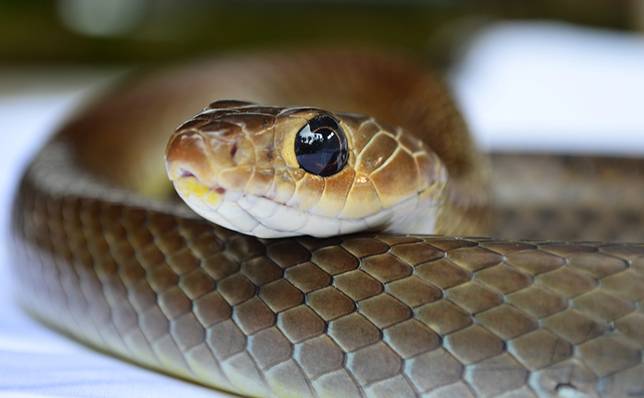A tour of my pet snakes with a quick how-to.
Introduction
There are many things to say about snakes, and keeping snakes as pet. This, is just an introduction tour of my situation, with some little basic informations of my own experience that will be enhanced/detailed a lot in future blog posts :-)
Hello
Hello from my Mojave Ball Python, Male, 6 years old :

From my Morelia Viridis, Male, 4 years old :
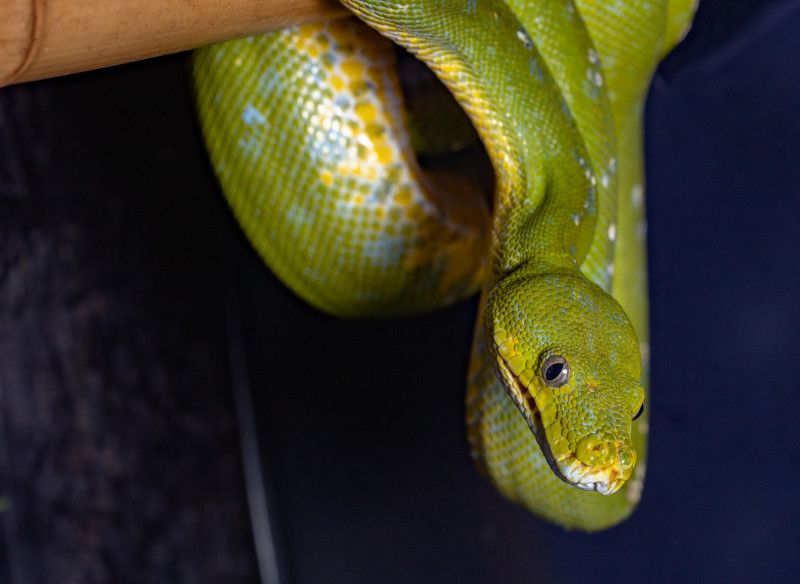
And from my Morelia Carinata, Female, 2 years old :
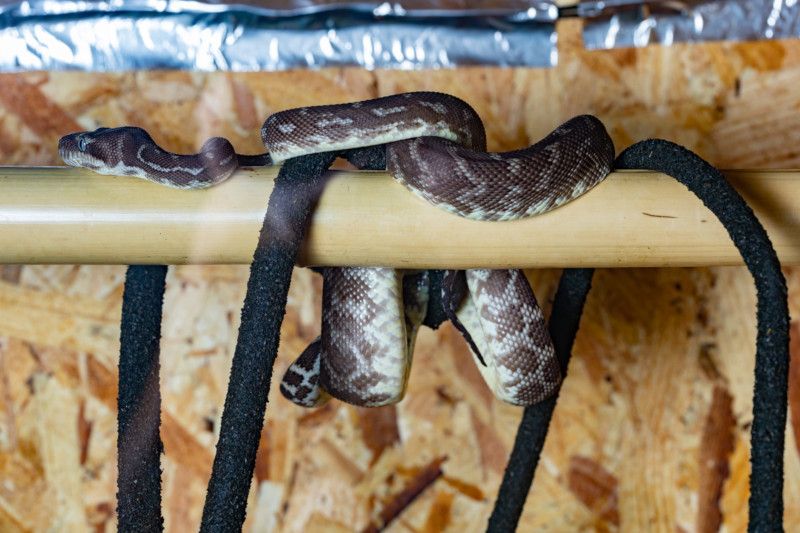
Yes I know, I don't give names to my snakes. Because I have no idea about naming, and snakes are not dogs : they are mainly deaf, and cant be called by their names thinking they will come to you : no, no, no.
Snakes as pet ?
Well yes, this is possible, absolutely.
I love wildlife, I'm fascinated by the differences we can find between the way we, Humans, are built , and some animals, especially snakes. Snakes have no arms nor legs : just one body. This simple fact by itself, is fascinating to me. They did have legs back millions years ago, but those are gone with evolution and adaptation on Earth, they are gone mainly because they became a drawback few millions years ago. With no legs nor arms, it is trully amazing how fast and agile you can get, and how you can reach places you could not, if equipped with legs or arms. Think about it a minute and get some litterature, this is exciting.
Many snake species can be kept as pets, with absolutely no problem, as soon as you understand the animal, what are its vital needs, how it feels its surrounding environment, and how it makes use of its senses. I will go deeper on this subject in a future blog post.
So yes, snakes are absolutely wonderful pets. Here are few rules about this :
- You most often watch the snake, much more than you physically interact with the animal. Snakes are not like dogs or cats : they dont appreciate a stroke, they will most often tolerate it.
- The relation is built in the same way as with a dog : know the animal, and adapt yourself to it, as the opposite will not work.
- Snakes have a tiny brain, very primitive, but there is still space for experience : They get used to you, they learn, they remember and they will recognize you among any one else, not using their eyes but other senses.
- Snakes are much more easy to take care of than dogs : they eat about once per month, they don't need to be run outside to relieve themselves, they only need you to provide them good temperatures (mandatory) and fresh water. Snakes can afford not eating a single meal for years, while still being alive and able to feed themselves, but snakes may suffer or die about ambiant temperature they are exposed to.
- You may leave them alone (with temperatures automation) for about a week, with noone to look after them. You will need to provide fresh water after such a period however. Snakes are lonely animals, they usually hide, don't move, and don't live together but alone.
- The price to acquire a snake and its enclosure is not very high (depends on the snake species), same for meal and furnitures.
- You should not acquire a venomous snake, or a very huge one. Most countries provide a bunch of laws to regulate that, get informations.
I will push more detailed informations on how to take care of a snake in a future blog post.
I compare to dogs or cats because dogs or cats are known by every human being. They are the most common pets, everyone knows how a cat or a dog "works" or behaves, mostly.
Snakes, venomous, constrictors, pythons, boas, cobras ? etc ... ?
Yes wildlife is huge, and its classification as well. I cannot detail everything I do know here, but just to let you know, I own only pythons at the moment.
Pythons are non-venomous constriction killing animals, that means that they got teeths - and sometimes pretty big ones - but no venom at all. They are ambush animals that kill their prey by constriction, aka they surround their bodies around their prey, and make it suffocate, before dying. Boas are constrictors as well. Constrictor animals are powerful, they got a big mass of muscle and can, starting from some size, hurt a human.
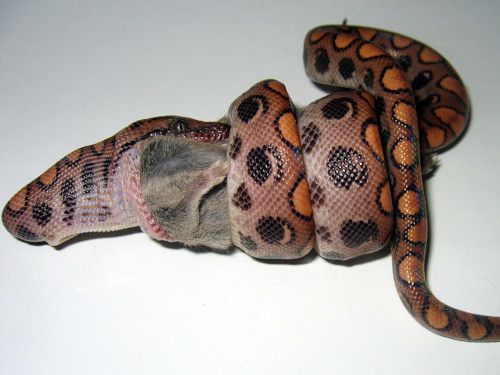
Why pythons ? Because I do like, that's all. Some people prefer grass snakes, some prefer venomous vipers or cobras ... You got every taste, for every soul ^_^ I like the design of pythons, how they are built. I take macro pictures that are so awesome to detail how true and pure the wildlife on Earth has been engineered, this is so exciting to me.
Are snakes dangerous ?
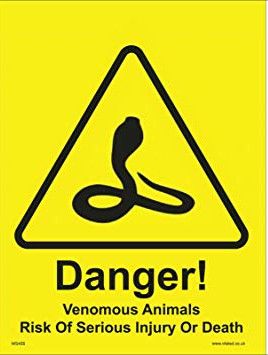
Is this dog, here in the street - or at your Home - dangerous ? Answer this question. The exact same answer can be given for snakes...
(Healthy) dogs are not dangerous, until .... Until you approach it as it is enjoying its meal ? Until you approach it and scare it ? Until you hurt it ? Until that particular individual has a temperament that makes it more nervous than others of the same species ?
It is all the same kind of rules and principles with snakes. As soon as you understand the animal you are about to interact with, you will have no problem - and by understanding - I mean deep understanding.
So yes, snakes can be dangerous, but same for dogs, for cats, for anything else. Same as well : some species/sub-species are known to be more "nervous" or "dangerous" than others.
Wildlife caught versus captivity native.
A snake that was born in captivity, that has never known the wildlife, and that has been in contact with humans since its first day... will have many more chances to be "cool", related to the one individual that you catch in the wild and that has never seen a human before but that has been harmed for all its life because of .... the wildlife.
So, as a general rule - which applies in many many cases - do not try to friend with a snake you see in the wild until you are full of years of experience. However, if you plan to acquire such an animal to keep it as a pet, you'd better choose one that is captive native from a serious breeder/seller, and ... not venomous obviously.
How to keep a snake ?
The basic rules are : not freely in your house ! Snakes are soooo damn good at escaping, climbing, embushing, balancing their body... And snakes can be very fast in their movement as well.
First thing first : A snake cannot generate heat by itself : it is a reptile, contrary to us humans, being mammals (and generating heat by ourselves). So if the snake cannot generate heat by itself, it needs to grab some heat from its surroundings, to stay alive, to reproduce, to digest.
A pet snake is kept in an enclosure, with heaters and sensors that keep the right temperatures every single second. This, is the absolutely mandatory thing to remember, and it is not complicated at all to achieve. The temperature gaps depend on the species, but as an average, the temperature should not fall under 20°C, and should not raise above 35°C. That's an average so that you get a feeling, the accurate temperatures to keep depend on the one species you want to own.
You will need a heat power source (heat cables, heat surfaces, many dedicated items exist), and a thermostat to regulate that.

Then usually (depends on species), a snake must hide so it must be provided some hidding places. Usually (some exceptions exist), snakes like warm, small and dark areas. Snakes are calm animals : they sleep a lot of time and then eventually look for food or explore their environment.
The size of the enclosure will vary with the size of the snake. Snakes like small, tiny, comfortable places : they will suffer from a too big enclosure and the lack of places to hide. This feels like paradoxal but I repeat : snakes suffer from too big and wide areas, sometimes you may see small enclosures, or what your mind tells you is too small, but no : they need a reasonable-sized space, that's all (relative to their own size, that's said).
After that, you need to provide a big water bawl, and refresh the water as many times as possible : just like with your dog. Water tend to get infected by many pathogens as the temperature grows and the water stays still : that can hurt your snake internal body : change the water often, I do it every day, every 2to3 days, or at maximum once per week. But like for a dog : it is mandatory to provide fresh water to your animal, at any time. Snakes drink (that's funny to watch) and snakes bathe.
Then, you should provide 12 hours of light, and 12 hours of night. If the enclosure is in a room that can't satisfy with normal daylight, use a lamp, not too high intensity, with a timer. Snakes are like us : they react to light and night cycles, they need them. Take care not to let the enclosure be hit by direct sun rays as the temperature into it will grow massively like in a hoven, reaching dangerous levels.
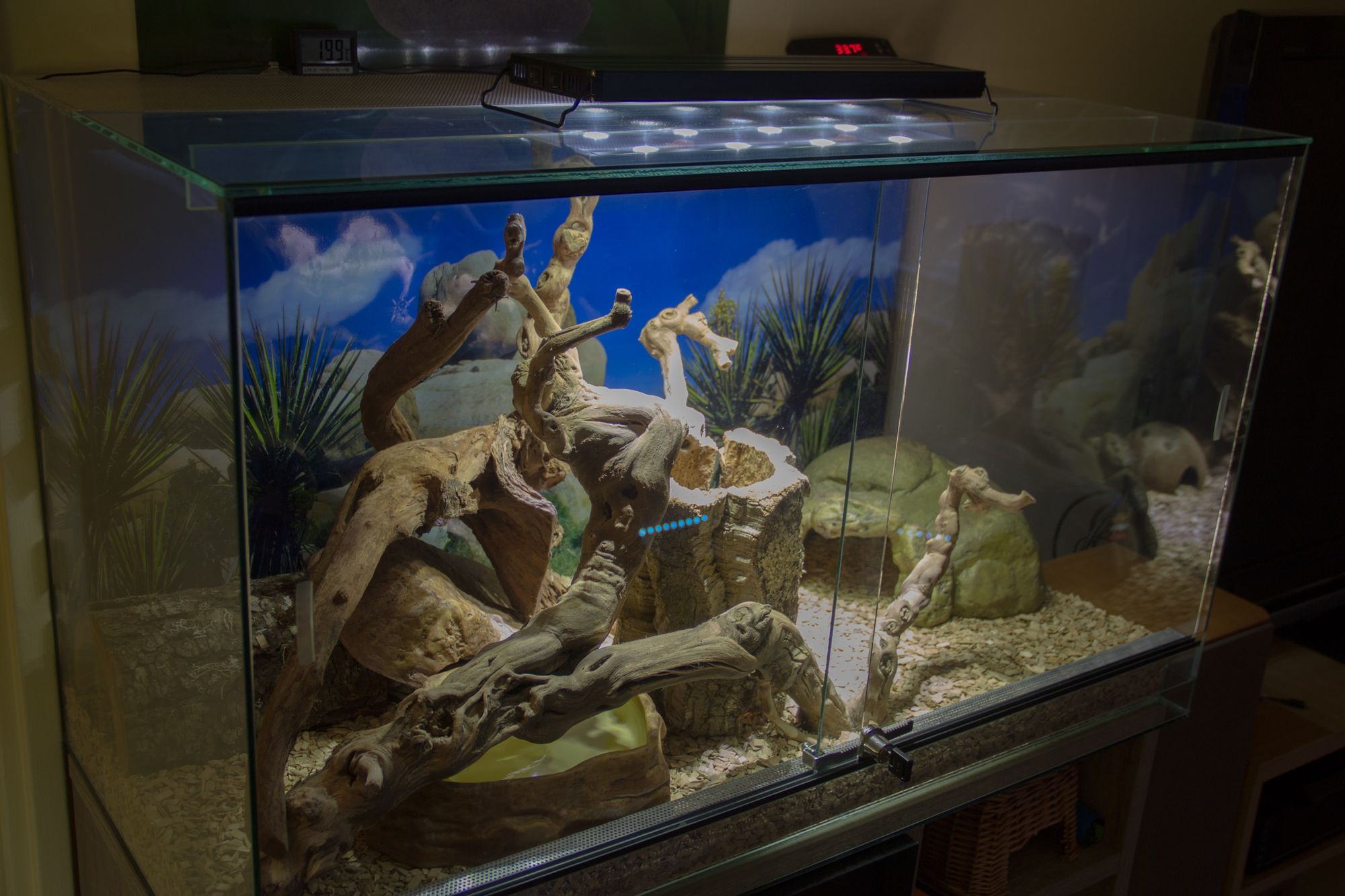
Some snakes have arboreal habits and will climb. Some others won't, or not that often. It is then good to provide branches so that the snake can climb. I got one full arboreal species (Morelia Viridis), and its enclosure looks a lot different from a ground-living ball python one for example.
I will provide more infos about temperatures etc... in a next blog post. If you experience a power failure, usually this doesn't last too long. Should you know that snakes can tolerate shortly cold temperatures, you have some time to find alternative solutions. If you carry a snake outside, that's in a closed soft bag, and during summer strongly preferably.
Feeding a snake
You feed young snakes once per week, adult snakes once per month. This is an average, get some accurate informations. Usually, you feed your snakes with rats or mices, depending on species, birds, rabbits, eggs..., can also be used for feeding.
I feed my snakes with dead, frozen-kept preys. I put those in medium-warmed water (about 40°C) to have them warm and unfrozen, but not cooked (So you dont put the prey in a hoven to heat it, for example). And with the help of some pliers/tweezers, I present it to the snake. A hot prey is important as many snakes are equiped super-powerful heat sensors around their mouth, and will use such a sense to recognize a prey (or your hand, that's why you use some pliers to feed them).
It is not recommanded to feed snakes alive preys (for many reasons). So be prepared to get to the reptile shop and buy some frozen rats or mices, and keep them into your freezer, yes.
Do I risk my life handling a snake ?
No. No as soon as the snake is not venomous, and under 3 meters long as adult size. It is commonly shared that when the species reaches 3 meters (adult) and above, it can represent a threat for a human as its size and muscle power can overcharge a Human's one. The weight can also become unmanageable (80Kg) and the rule then is to be more than one human to handle such a species. Definetly not for beginners though.
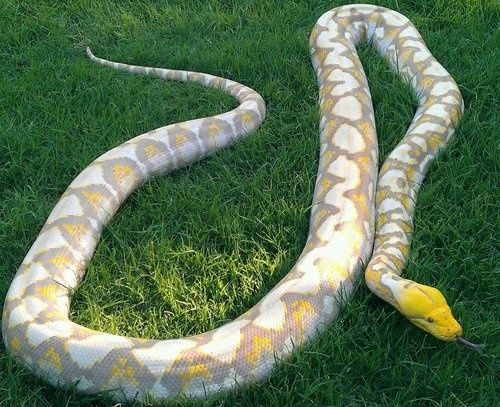
In many countries, you won't be allowed to keep a snake that reaches > 3 meters adult size without following a long training session with professionals and obtaining a licence. It is the case in France for example.
It is even more complicated when you start talking about venomous, and thus very dangerous snakes (they usually kill a human in less than an hour after a venomous bite).
So no : you won't risk your life handling your pet snake until you own venomous or huge ones ;-)
I'm scared of snakes, and scared of being bitten.
If you are scared, or more : phobic , then there exists some trainings to make you reach confidence again.
If you are not phobic (which is a true pathology that can be recovered from) but only apprehensive, that is normal, and you should not. There exists so many snake species that are known to be very tamed and very cool with humans.
Some things to remember :
- Snakes are not programed on Earth to kill humans. Humans are the predators and the snakes are unfortunately the preys in the history. So snakes will perhaps feel threatened, and thus will defend themselves, but they will not attack you to kill you and eat you : this is what you see on TV and in movies, this is not reality.
- Snakes may eventually consider you are a threat. In the wild, humans kill snakes, they hunt them. As you are very tall and big compared to the snake, it will fear you and will try to hide and escape first, not to bite you like a beast...
- A snake will bite you if it feels threatened for its own life, and if it has no place to escape. A snake always warns you before bitting, like a dog does, it is very rare it does not. Once more, the snake will usually try to escape (if it can) instead of turning to bitting you first. Bitting requires some energy, and snakes are energy saving animals.
- A snake will probably bite you if it feels hungry, and if you move your hand around him. Most (not all) snakes have a bad view, but very good heating sensors and smelling capabilities (using their tongue) : it will easily confuse your warm hand for a rat.
- Snakes being in contact with humans since their first day (captive native) and gently taken care of and maintained, will almost often show no aggressivity at all against humans (as soon as it stays in good health conditions). It's all about individuals.
- Snakes handling is all about experience and learning. Snakes have a body language like a dog will grumble at you before bitting you. Snakes show moods - they are alive animals you know - and you can read and understand their mood ("hello I'm cool", "Rrh I'm hungry", "Psssss Leave me alone", "Mmm who's there ?", "Huh I'm sleeping").
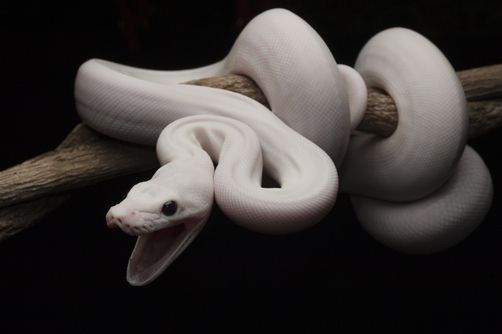
I've been keeping snakes for years now, and I've only been bitten once and just once. When you get bitten, it is your plain fault and never the animal one. I effectively did a mistake I understood after being bitten. If the snake is not venomous (obviously it is not !) and not huge : the bite is nothing to something medium. No big pain, its like a scratch plus a hit together. But it may hurt if the snake is big or big-teethed. Also, a bruise may appear as the snake hits you with many power in case of offensive bite. As the snake is equipped dozens of teeths like points : it bleeds, sometimes high bleeding but that stops very fast. You then disinfect, and in about a few days, you don't see anything else, the wound has dissapeared.

So that's it, you may use a snake hook to approach your animal, I do use one when I know I must (feeding scenarios or bad mood). Like I said, if you correctly read the snake and handle it in such a way it defocuses from you, and relaxes; then you shouldn't receive a bite, just show it you're a good soul, not a threat to it. It can understand the situation : take the time to show it the way.
If you need a feeling of my real experience : my snakes are not bitty at all, but very cool. Feeding is always a risk : I use tools. Handling is just all right, pretty nice animals sliding onto your body, a nice, comfortable and safe feeling. Always keep calm, even if the animal feels nervous, no quick moves : transmit it your good purposes and it just works.
Snakes sub-species patterns, colors, morphs
I like snakes for all they are, among that is their colors and patterns, what breeders call "morphs". The human being has been reproducing many snakes species and sub-species - and played with genetics - for dozens of years now. When I say "played with genetics" its all about finding the right male to reproduce with the right female, nothing "bad" about bioethics. Get your informations, snakes genetic laws are pretty hard to understand :-D
There exists tons of morphs, especially in the pythons and boas species (but not only). A simple search engine for images with "ball python morphs" terms will show you.
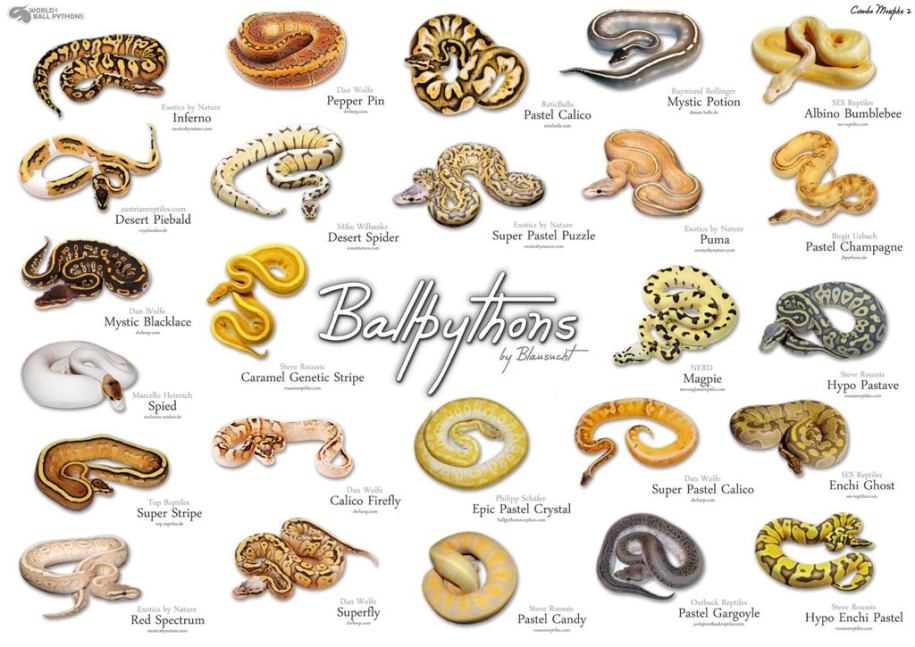
It's all about taste. You will first choose the species and sub-species, then probably the morph, the age, the sex; your personnal choices here. Too many things to say here ;-)
Much more to come
I will provide more informations about how I do keep my snakes. The Web is also full of informations, most of them being true (but some are wrong). If you are interested, talk to a professional or someone that has been owning snakes for many years.
I especially appreciate those English-speaking Youtube channels :
- Brian Barczyk
- Clint's Reptiles
- Snake Discovery
- New England Reptile
- Reach Out Reptiles
- Chrisweeet
- DAVIDSFEED
Yes you can see videos or images of dangerous snakes : they do exist right ? I did not say the opposite but they are not alone on Earth :-D
The next species I would like to acquire are Albertis python and reticulated or burmese python, which require me to get a 50+ hour training and get a licence to be allowed to own such snakes.
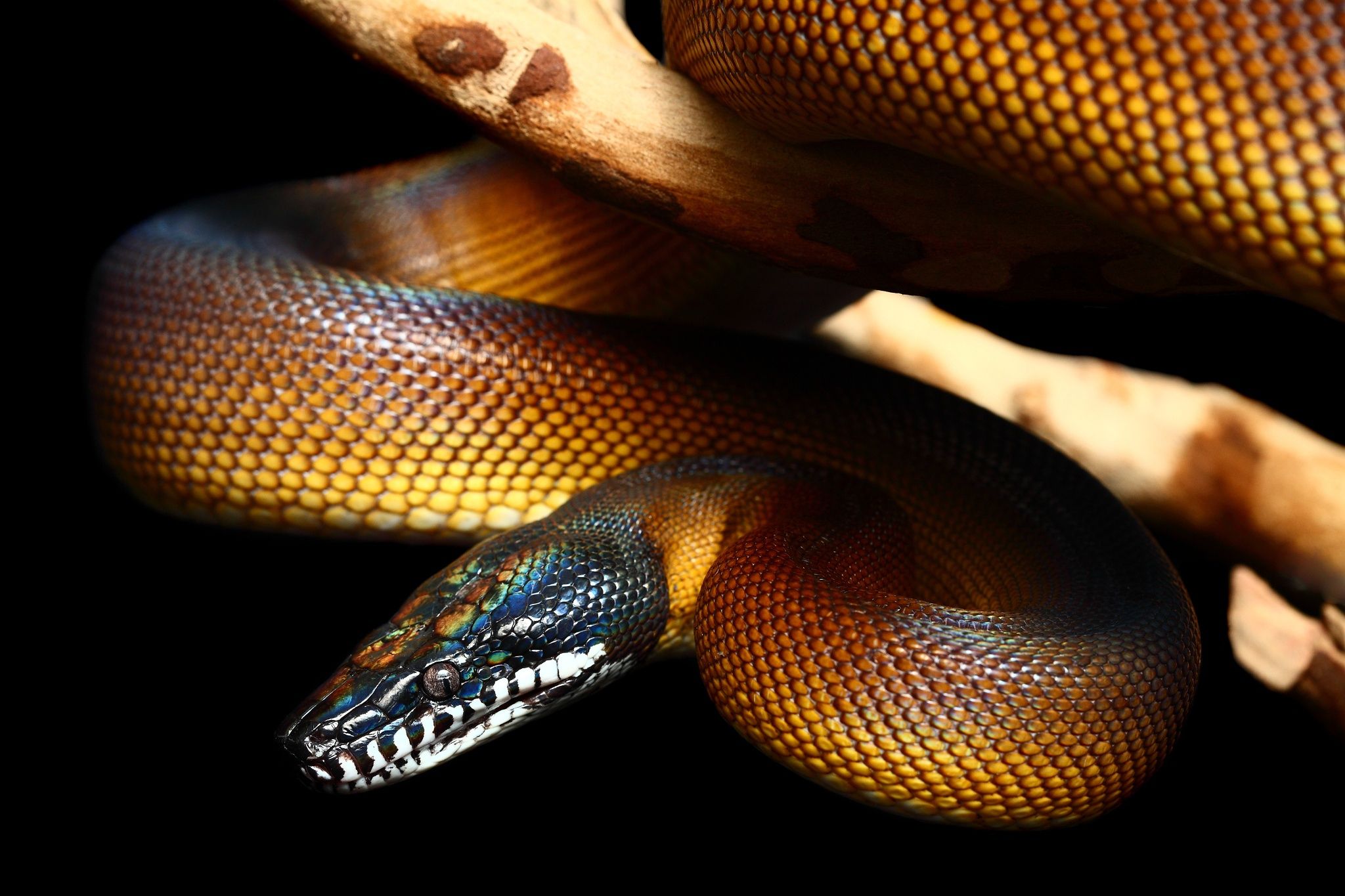
Should you lastly know that the life expectancy of many snakes is between 20 to 30 years. 40-or-so years are exceptionnal but have been seen.
